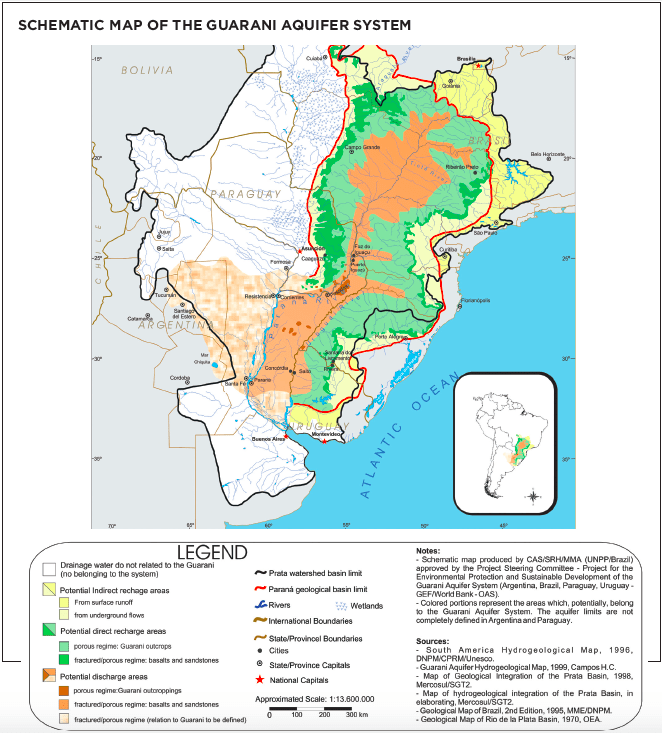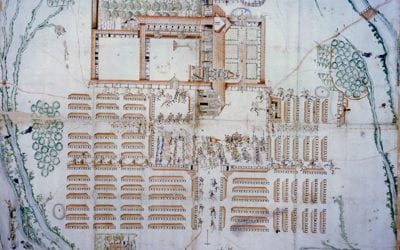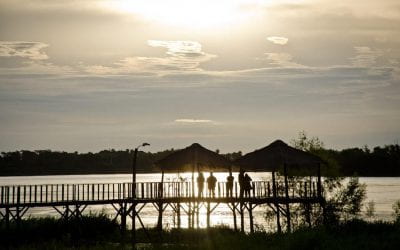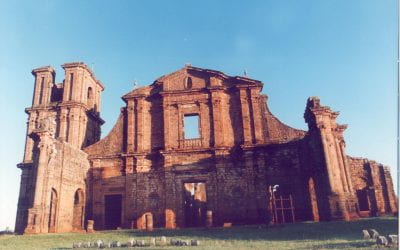The Invention of the Guarani Aquifer System
New Ideas and New Water Politics in the Southern Cone
On October 19, 1979, the presidents of Argentina, Brazil and Paraguay gathered in Asunción to sign an agreement setting general principles for the utilization of the Paraná River, a major waterway shared by the three nations. The agreement enabled the construction of hydroelectric dams in the basin and eased the tensions resulting from the competitive exploitation of the watershed. Decades later, in 2003, authorities from Argentina, Brazil, Paraguay and Uruguay would meet again to launch a cooperative process to determine how to govern their shared waters. This time, the objective was to develop instruments to manage and protect the Guarani Aquifer System (GAS), a transboundary groundwater basin spanning over more than 1.1 million square kilometers and considered one of the largest freshwater reservoirs in the world (see Figure I). By 2010, the countries had implemented several new local-level policies and ratified a framework agreement to manage and protect the aquifer system.
Countries in the Southern Cone had been quarrelling—and striking agreements—over shared surface waters since colonial times, but policy for the GAS was in many ways different. Similar to other shared water policies, the governance mechanisms created for the GAS emphasized each of the countries’ in-alienable sovereignty over the resource and enshrined reciprocal no-harm and sustainability as guiding principles for the future exploitation of the resources. However, the GAS policies dealt with an entirely new kind of water resource—transboundary groundwater—for which few countries in the world have managed to strike formal governance agreements. More importantly, they were developed at the initiative of local non-state actors supported by international organizations. Unlike previous shared water policies created to respond to the needs and plans of national authorities, the new shared water governance instruments were expected to help promote local and sustainable development.
Ideas played a key role in the development of the GAS policy. Indeed, the notion of a transboundary groundwater body in the Southern Cone only emerges in the final decades of the 20th century. Before then, although the existence of aquifers in the region was well known, scientists had failed to identify the transnational linkages between groundwater bodies. The aquifers that make up the GAS were studied as separate entities under different names. Understanding local aquifers as a single interconnected basin subverted the established compartmentalized approach to the study of local groundwaters that had prevailed until then. Local hydrogeologists first theorized and then defended this view in opposition to the interpretation of experts from canonical disciplines of geology and hydrology. Seminal hydrogeology studies conducted during the 80s and 90s would provide empirical support for the single aquifer system theory. At the same time, hydrogeological research contributed to the development of new epistemic communities, leading to the emergence of a new group of experts who shared the belief that the regional aquifer existed, and that its resources would require new policies in order to be protected. Regional hydrogeologists agreed on a unified name for the aquifer system—the name “Guarani” was chosen for its sociocultural implications instead of a more conventional nomenclature—as well as on a strategy to gather further financial resources to study the aquifer. In the late 90s, scientists wielding a new idea kick-started a process of international cooperation among political entities, a process that would shape policy for the waters of the GAS.
The idea of the GAS was scientifically controversial because the geological formations that make the GAS are extremely dissimilar across the region, but it was also politically compelling. The existence of a unique system of connected aquifers implied that groundwater exploitation decisions were interdependent. It meant that groundwater exploitation practices were having an impact beyond jurisdictional borders, and that some degree of international coordination would be necessary to adequately exploit the resources in the medium to long term. Also, the unified conceptualization of the aquifer system helped draw additional attention to specific local management challenges, for it turned them into components of a larger, more strategically significant shared water governance issue. The idea of a unique regional aquifer helped to raise the profile of provincial challenges in the national political agenda and obtain additional resources.
The invention of the GAS can also be understood as a byproduct of democratization. With democracy, regional academic institutions gained autonomy from central government decision-making. New academic disciplines such as hydrogeology blossomed and focused on new issues relevant to local and regional interests. Political change helped people to focus on new problems relevant to local economic development. At the same time, more permeable borders facilitated the development of transnational knowledge networks and epistemic communities by helping to foster the social relationships behind the transnational policy initiative. The international cooperation process that would lead to policies for the GAS reflected the initiative of local actors seeking practical solutions to their problems, rather than the strategic response from centralized authorities that was prevalent in the decades that preceded democratization.
Indeed, the invention of the GAS was the expression of new international relations in the Southern Cone. Still, new ideas cannot explain policy outcomes. Governance instruments for the aquifer system developed concomitant to the increasing demand for the resources in the region. Groundwaters were becoming an increasingly crucial component of diverse economic activities—i.e., the supply of fresh-water for urban consumption in southern Brazil, crop irrigation in Paraguay, and thermal tourism operations in Argentina and Uruguay. These practices led to the slow yet noticeable quantitative and qualitative deterioration of the resources. Lack of regulation encouraged, for example, the proliferation of groundwater wells, the contamination of recharge zones, and the absence of proper well-drilling standards. These new problems prompted demands for solutions.
The regional scale of the aquifer system catalyzed the recognition of the potential geostrategic value of the resources and prompted the involvement of public officials at the national level. Driven by the demands of regional scientists and local stakeholders, but reflective of the strategic interest of the national governments, groundwater issues entered the political agenda. The countries engaged in a process of multilateral cooperation and established a project—co-financed by an international organization, the Global Environment Facility—for the assessment of resources and the established regulatory frameworks in the year 2000. The initiative helped develop a knowledge base for the development of policies aimed at the protection and sustainable management of the aquifer system. The international cooperation project concluded in 2009 with the production of a strategic action plan for the GAS, which was rooted in concrete management policies at the local, regional and national levels. Information gathered through the cooperation process was centralized in a system of publicly accessible geographic information to aid decision-makers. On this basis, local stakeholders implemented new well drilling standards, determined minimum buffer zones between wells, and protected vulnerable recharge areas. The action plan also led to the signature of a multi-lateral framework agreement in 2010, which outlined general non-binding principles for future transboundary groundwater governance in the region.
If anything, the process that led to the creation of the governance instruments for the management and sustainable exploitation of the GAS shows the many roles that scientific knowledge plays in modern environmental politics. Information about transboundary groundwaters was simultaneously instrumental to the introduction of the resources in the political agenda and the political negotiation of concrete management provisions. In fact, the process of political recognition of the resources was inseparable from the emergence of new theories about the aquifer system’s scale and from the struggles for peer recognition of the regional scientists. Moreover, official negotiations about the “new” shared resources—the waters stored in the Guarani Aquifer System—resulted from the mobilization and interest of actors who, historically, had been marginal in regional politics. Instead of being designed and directed exclusively according to the preferences of central government agents, the governance of the aquifer system was fostered by subsidiary political authorities and non-state actors: expert networks and international organizations.
Tracing the role of ideas in policy-making is a challenging endeavor, for they are both the expression of contextual factors and powerful drivers of change. The recognition of groundwater problems results from the interplay of particular groundwater exploitation patterns, the increased understanding of the factors behind hydrogeological conditions, and the changing social value attributed to the services provided by the resources. None of these factors, taken individually, is sufficient to explain the entry of groundwater problems in the political agenda. Reliance on groundwaters increases the value of the services provided by the resources, albeit only given a “sufficient” understanding of the factors behind the deterioration or depletion of the resources. Simultaneously, the value of groundwater resources is shaped by the availability of hydrogeological information and modeling techniques because it both exposes the causes of groundwater degradation and determines the stakeholders’ ability to exploit and to manage groundwater resources. The interactions of these three factors highlight the social nature of groundwater problems.
The processes of social construction that lead to the recognition of groundwater problems are too often ignored by the literature dedicated to water governance. Problems tend to be taken for granted—seen as existing a priori of the policy-making process—or, alternatively, framed as purely instrumental to the strategic preferences of political actors. In this sense, perhaps the most significant contribution of the constructivist approach to international water policy is that it highlights a constitutive phase of the policy process. It emphasizes that the recognition of groundwater issues is concomitant with the formulation of preferences vis-à-vis the management of the resource; in other words, it stresses that the acknowledgement of groundwater problems is inseparable from the involvement of actors in the political process and from the entry of the resources into the political agenda. This is a process driven not just by “objective facts,” but also by the changing meaning of these facts in specific socio-historical contexts.
Spring 2015, Volume XIV, Number 3
Martin Walter is currently a consultant at the Inter-American Development Bank. He has a Ph.D. in Political Science from Northwestern University and the Institut d’Etudes Politiques de Paris, and his work deals with the socio-political intricacies of implementing projects for the protection and sustainable development of natural resources. He can be reached at mw.martinwalter@gmail.com.
Related Articles
Jesuit Reflections on their Overseas Missions
When you think of Jesuits in their missions around the world, you—the casual reader—might not think of Plato or ancient Greek authors. Yet two of these…
Paraguay: Un país en una lengua misteriosa y singular
English + Español
If you arrived in a country where almost 90% of the inhabitants speak Guarani, an official and national language along with Spanish but do not identify themselves as “Indian” or aboriginal…
Territory Guarani: Editor’s Letter
DRCLAS receptions are bustling affairs, sparkling with ample liquor, Latin American tidbits and compelling conversations. It was at one of these receptions that Jorge Silvetti and Graciela Silvestri first approached me casually regarding an issue about the Guarani…





